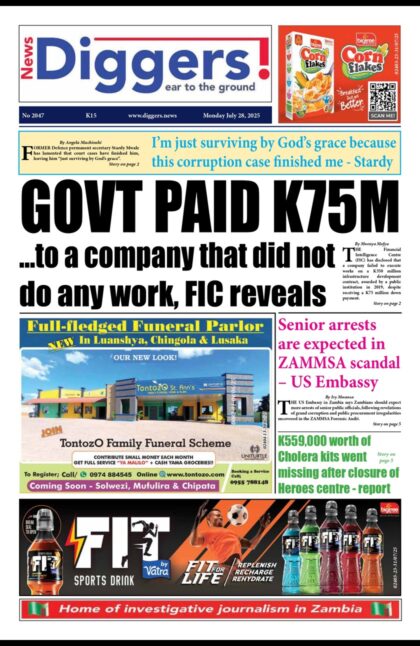FQM Trident Limited General Manager Sean Egner has refuted reports that the mining giant plans to take over the running of Mopani Copper Mines and Konkola Copper Mines on the Copperbelt.
And FQM Assistant General Manager Junior Keyser says the upcoming nickel mine in Kalumbila district is likely to put Zambia among the top 10 producers of the commodity in the world.
Addressing the media during the tour of Kalumbila mine, Thursday, Egner said the company currently did not have enough resources to take over the running of the said mines, adding that the mines’ focus, for now, was to grow its existing projects.
“I think that that story that was published was a misquote. FQM’s primary focus here in Zambia is the enterprise project here at FQM Trident as well as the potential expansion project which is at concession, which is called the S3. Both of those represent huge capital investment and capacity growth for Kansanshi or FQM Trident. I don’t think that we have the resources to take on any additional mine in Zambia at this time,” he said.
Egner said the company planned to ramp up its production in 2022, especially with increased copper prices on the international market.
“In 2021 we saw sentinel producing 232, 000 tons of copper for the year. In 2022 we intend to see sentinel move to 63MBCM as we continue to open our eastern cutback and optimize the use of our 4th input crusher. The crusher was a major project for us during 2021 and helps maintain the haul distance as we extend the pit, keeping sentinel cost effective. 2022 will see us focus on consistent operation of our new equipment. With steady volumes and throughout we need to run at these levels consistently over the next years. We continue to keep our Enterprise Project at the ready as we are hopeful of an opportunity to start mining, the Zambian government is serious to see mining grow in Zambia and this project has great potential in stable regime. And in terms of taking advantage of the copper prices, I think it’s a good time now for us to mine in volumes. As indicated we plan to step up our production levels,” he said.
“The recent installation of crusher 4 together with our various upgrades and debottlenecking to our process, we see us ramping up our plant fees to 62 Mtpa rates with a forecast copper production of between 260, 000 metric tonnes and 280,000 metric tonnes.”
He said the current mining tax regime in terms of royalties was good for investment.
“The tax regime in terms of royalties has definitely made a difference. It makes Zambia more favourable for investment. The stability of that is critical. I think in general people are comfortable with changes that the government has proposed and implemented. The fuel we are subjected as well as all Zambians are subjected to, fluctuating crude oil prices and its impact on diesel, what we have done is we have got arrangements to bring fuel into the mine to meet our demands. And obviously, it comes in with an increasing cost every month as the price changes. So that affects profitability but so far we haven’t seen any impact in terms of lack of supply. And I think what is more important for us is that we need the diesel to be able to mine. As I indicated the fleet is predominantly electric. The truck they all run on diesel, so we need diesel to keep those guys moving,” said Egner.
And the company’s Assistant General Manager Junior Keyser said the upcoming nickel mine in Kalumbila was likely to put Zambia among the top 10 producers of the commodity in the world.
“Very easy to get the enterprise going less than a year to commercial production. Ultimately enterprise is a greater opportunity. Nickel price is strong at the moment. We have been looking at 35,000 to 40, 000 tons of nickel per annum and that will price us as one of the top 10 nickel producers in the world. So the process plant is at 90 percent complete, the project is very easy to recommend so in the past six months we have done a lot work; development work, infrastructure development work. But from the word go to enterprise it’s less than twelve months to get it up to commercial production. And because it is a very small mine and the nature of nickel is very erratic and dependant on a low market, we will be a mining enterprise with the contractors. And because it is a very small operation, we are looking at 600 people that we will be employing directly,” said Keyser.


















